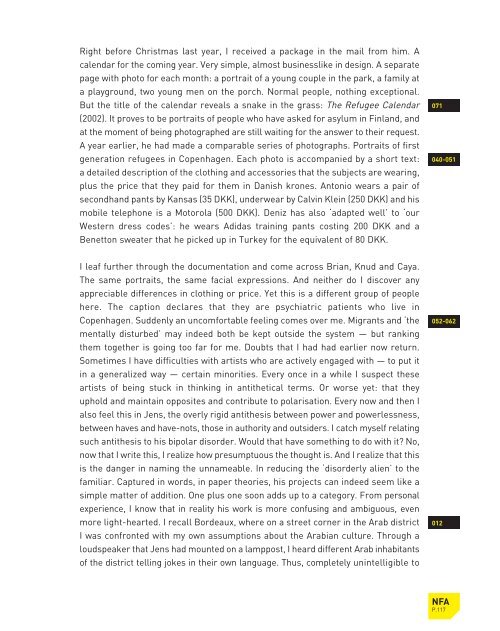download catalogue high resolution pdf (22.3 mb) - Jens Haaning
download catalogue high resolution pdf (22.3 mb) - Jens Haaning
download catalogue high resolution pdf (22.3 mb) - Jens Haaning
Create successful ePaper yourself
Turn your PDF publications into a flip-book with our unique Google optimized e-Paper software.
Right before Christmas last year, I received a package in the mail from him. A<br />
calendar for the coming year. Very simple, almost businesslike in design. A separate<br />
page with photo for each month: a portrait of a young couple in the park, a family at<br />
a playground, two young men on the porch. Normal people, nothing exceptional.<br />
But the title of the calendar reveals a snake in the grass: The Refugee Calendar<br />
(2002). It proves to be portraits of people who have asked for asylum in Finland, and<br />
at the moment of being photographed are still waiting for the answer to their request.<br />
A year earlier, he had made a comparable series of photographs. Portraits of first<br />
generation refugees in Copenhagen. Each photo is accompanied by a short text:<br />
a detailed description of the clothing and accessories that the subjects are wearing,<br />
plus the price that they paid for them in Danish krones. Antonio wears a pair of<br />
secondhand pants by Kansas (35 DKK), underwear by Calvin Klein (250 DKK) and his<br />
mobile telephone is a Motorola (500 DKK). Deniz has also ‘adapted well’ to ‘our<br />
Western dress codes’: he wears Adidas training pants costing 200 DKK and a<br />
Benetton sweater that he picked up in Turkey for the equivalent of 80 DKK.<br />
I leaf further through the documentation and come across Brian, Knud and Caya.<br />
The same portraits, the same facial expressions. And neither do I discover any<br />
appreciable differences in clothing or price. Yet this is a different group of people<br />
here. The caption declares that they are psychiatric patients who live in<br />
Copenhagen. Suddenly an uncomfortable feeling comes over me. Migrants and ‘the<br />
mentally disturbed’ may indeed both be kept outside the system — but ranking<br />
them together is going too far for me. Doubts that I had had earlier now return.<br />
Sometimes I have difficulties with artists who are actively engaged with — to put it<br />
in a generalized way — certain minorities. Every once in a while I suspect these<br />
artists of being stuck in thinking in antithetical terms. Or worse yet: that they<br />
uphold and maintain opposites and contribute to polarisation. Every now and then I<br />
also feel this in <strong>Jens</strong>, the overly rigid antithesis between power and powerlessness,<br />
between haves and have-nots, those in authority and outsiders. I catch myself relating<br />
such antithesis to his bipolar disorder. Would that have something to do with it? No,<br />
now that I write this, I realize how presumptuous the thought is. And I realize that this<br />
is the danger in naming the unnameable. In reducing the ‘disorderly alien’ to the<br />
familiar. Captured in words, in paper theories, his projects can indeed seem like a<br />
simple matter of addition. One plus one soon adds up to a category. From personal<br />
experience, I know that in reality his work is more confusing and a<strong>mb</strong>iguous, even<br />
more light-hearted. I recall Bordeaux, where on a street corner in the Arab district<br />
I was confronted with my own assumptions about the Arabian culture. Through a<br />
loudspeaker that <strong>Jens</strong> had mounted on a lamppost, I heard different Arab inhabitants<br />
of the district telling jokes in their own language. Thus, completely unintelligible to<br />
071<br />
040-051<br />
052-062<br />
012<br />
NFA<br />
P.117


